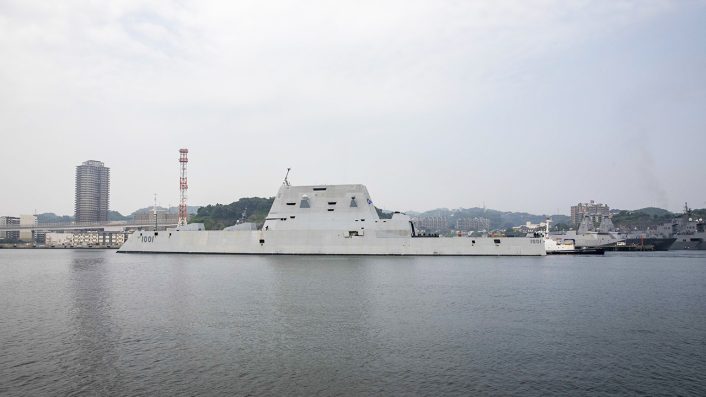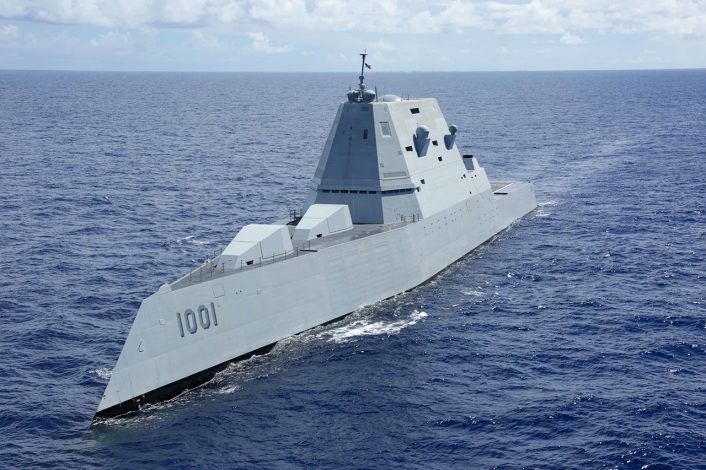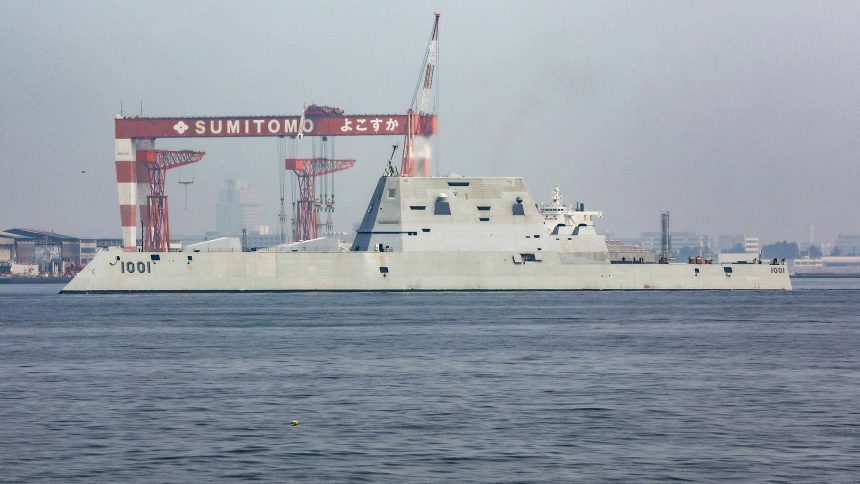The ship is the first Zumwalt class to visit Yokosuka since USS Zumwalt’s 2022 visit, which was the first ever port call for the class in the Western Pacific region.
USS Michael Monsoor (DDG 1001), the second ship in the distinctive Zumwalt class of stealthy guided missile destroyers, arrived at Fleet Activities Yokosuka on Jul. 7, 2025 while forward deployed with Destroyer Squadron 15 (DESRON 15).
これは宇宙戦艦って言われた方がしっくり来る https://t.co/AGtDT8VTdi pic.twitter.com/1tnv7b5F2T
— ⚓︎アルザス⚓︎ (@Alsace_class) July 7, 2025
DESRON 15 is the largest destroyer squadron in the U.S. Navy, usually comprising around ten Arleigh Burke class guided missile destroyers. The ships are based in Yokosuka, but undertake activities across the Western Pacific both independently and in support of U.S. carrier strike and amphibious ready groups. It’s unclear if the Monsoor is complementing existing units, or replaced an Arleigh Burke on the squadron’s strength.

Though much larger than the Arleigh Burke class, displacing almost 15,000 tons, the Zumwalt class at present arguably offers a much reduced capability in comparison. The large 155 mm Advanced Gun System (AGS) turrets on the forward deck, in stealthy housings, are inoperable and without ammunition due to budget constraints. With only three ships produced, with six guns between them, production costs for its unique ammunition soared to between $800,000 and $1 million per round.
Eighty Mark 57 vertical launch system (VLS) cells provide the ship with its primary offensive and defensive armament, essentially analogous to the Mark 41 VLS installed on Arleigh Burke class destroyers and capable of firing the same missiles. The Mark 57’s improved exhaust system, intended to allow for more capable missile designs, has not been exploited to its full potential as any missiles developed specifically for it would not be compatible with the ubiquitous Mark 41.
Target Acquired!#USSZumwalt (DDG 1000) successfully executed the first live-fire test of the MK 57 Vertical Launching System with a Standard Missile (SM-2) on the Naval Air Weapons Center Weapons Division Sea Test Range. #NavyLethality
Read More 👇 https://t.co/JzRZLl7c1h pic.twitter.com/H2TfcXoXfu
— U.S. Navy (@USNavy) October 19, 2020
With the Zumwalt’s intended role, providing naval gunfire support, impossible with the non-functional guns, the ships have spent their service lives in search of a purpose. Finally, in August 2023, USS Zumwalt (DDG 1000) arrived at Huntington Ingalls Industries (HII) in Mississippi for an overhaul that saw its two AGS turrets removed and replaced by four large launch tubes, 87 inches in diameter, that will each house three hypersonic missiles. The missile chosen to equip the ships is a variant of the U.S. Army’s Long-Range Hypersonic Weapon (LRHW) through a project named Intermediate-Range Conventional Prompt Strike (IRCPS).
Zumwalt re-entered the water in late 2024, though integration works remained ongoing. USNI News reported that the modification left the rear AGS’ below deck equipment and magazine intact – the fixed, non-rotating part of the turret mount can also be seen still on the deck, though without the gun itself. USS Michael Monsoor will also eventually go through the process, though the third and final ship of the class, the Lyndon B. Johnson, is being converted during its lengthened construction phase.

Though currently without this new missile capability, the deployment of the USS Michael Monsoor to the Pacific region will still be an important opportunity for the ship’s crew. When the ship heads in for its modifications, members of the ship’s company may well be called upon to serve aboard the USS Zumwalt, or even the USS Lyndon B. Johnson when it enters service, so experience in operating the type in a forward deployed role would be very beneficial.
In Washington D.C., while the first six months of President Trump’s second term have seen extensive operations in the Middle East, the administration’s overall strategy is still aimed towards the Indo-Pacific and specifically at countering Chinese influence. While the Zumwalt class as a whole has long been earmarked for basing out of San Diego, on the U.S. Pacific coast, it wasn’t until three years after the USS Zumwalt’s first operational deployment that the ship ventured beyond Hawaii towards Guam and Japan.
With the class’ very distinctive and imposing appearance, in some cases leading to comparisons to Imperial Star Destroyers from Star Wars, any deployment or activity involving them becomes very high profile. Compared to Arleigh Burke class destroyers, which are the U.S. Navy’s workhorses and can often travel relatively unnoticed, the Zumwalt class turns heads wherever it goes. This can be useful for signaling he U.S. Navy’s presence in a region even without the new hypersonic missiles.
Future Upgrades
Powered by two Rolls Royce MT30 gas turbines, just like the UK’s Queen Elizabeth class aircraft carriers, The War Zone reports that the ship generates 78 megawatts of electrical power, with 58 megawatts still in reserve at cruising speed. This is a vast increase over the power generation capabilities of the Arleigh Burke class, and means there is a huge overhead in terms of integrating new systems.
Directed energy weapons (DEW), commonly referred to as laser weapons (though other DEW types exist), are one such example of an emerging technology that could be integrated, and one that does rely heavily on power generation. The U.S. Navy has integrated DEW systems on Arleigh Burke class destroyers but these are relatively low-power designs suited primarily to counter small drones and missiles, or for blinding sensors.
The US Navy released a new photo of USS Preble (DDG-88) firing her HELIOS laser weapon. pic.twitter.com/oL4rMsA4Xu
— OSINTtechnical (@Osinttechnical) February 3, 2025
Railguns have also been touted, particularly as a more direct replacement for the AGS in a naval gunfire support role. For a time, it seemed very possible that one of the two traditional guns would be replaced by an experimental railgun during the Lyndon B. Johnson’s build, but this plan was rejected in favor of the hypersonic missile launch system. U.S. funding for research into railguns in general has been cut dramatically in favor of missile-based solutions with a longer stand-off range.
Other nations have continued to trial the weapon type, which uses electromagnets to propel projectiles at great velocities. In 2023, Japan claimed to be the first nation to test fire a railgun from a ship, and earlier this month a prototype operational railgun was seen installed on JS Asuka (ASE-6102) – a destroyer-like ship used specifically to test and trial new technologies.
Railgun Installed On Japanese Warship Seen In New Photos
The turreted prototype installed on a testbed surface combatant is the latest step forward in Japan’s work on railguns, something the U.S. Navy shelved years ago.
Story: https://t.co/Hn4VzoU0M6
— The War Zone (@thewarzonewire) July 1, 2025
China has also claimed to have tested a railgun at sea, in fact before Japan had done so, but it has yet to demonstrate any evidence for such a test having actually taken place. Japan, meanwhile, combined its announcement with a video of their test.
One of the biggest limitations for railguns is their adaptability for use outside of a naval context. While America’s hypersonic missiles can be launched from land or sea, railguns, with their immense power requirements, would be impractical to deploy at scale in land warfare operations. Ships already bring their powerplants, which can generate comparable energy supplies to those used by entire towns, with them into battle – the power generators that accompany mobile ground forces are much smaller and more limited.









